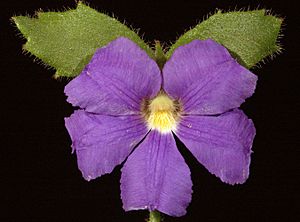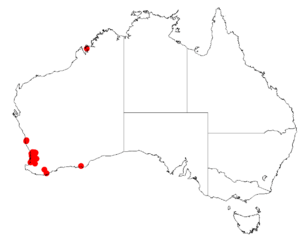Hairy fan-flower facts for kids
Quick facts for kids Hairy fan-flower |
|
|---|---|
 |
|
| Scientific classification | |
| Genus: |
Scaevola (plant)
|
| Species: |
pilosa
|
 |
|
| Occurrence data from Australasian Virtual Herbarium | |
The Scaevola pilosa, also called the hairy fan-flower, is a special plant. It's a type of herb that lives for many years. It belongs to the Goodeniaceae plant family. You can only find this plant in the southwest part of Western Australia.
Contents
What Does the Hairy Fan-Flower Look Like?
The hairy fan-flower is a small plant. It can grow up to 70 centimeters (about 2.3 feet) tall. It has many hairs all over it. Some hairs are tiny, while others are a bit longer.
Leaves and Flowers
The leaves at the bottom of the plant are bigger. They are about 1.5 to 7.5 centimeters long. They also have small teeth near their tips. The leaves higher up on the plant are smaller. They do not have stalks.
The flowers grow in a long cluster called a raceme. This cluster can be about 50 centimeters long. The flowers are blue or purple. They have white hairs on the outside. Inside, they look like they have a beard! The flowers bloom from September to December.
Fruit
After flowering, the plant produces small fruits. These fruits are shaped like an oval. They are about 5 millimeters long. Just like the rest of the plant, the fruits are also hairy.
Where Does the Hairy Fan-Flower Live?
This plant is found only in certain areas of Western Australia. These areas are called IBRA regions. You can find the hairy fan-flower in the Geraldton Sandplains, the Swan Coastal Plain, and the Jarrah Forest.
How Did It Get Its Name?
The Scaevola pilosa was officially named in 1837. An English botanist named George Bentham gave it this name. The word pilosa comes from a Latin word, pilus. This means "hair." So, the plant's name describes how it is covered with many soft hairs.

